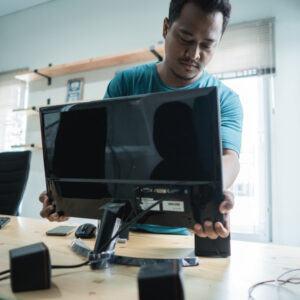Whether you’re on a remote or hybrid office schedule, homeschooling your kids, running your business from home, or tackling everyday life responsibilities, home office organization is key to staying productive. That’s why we’re offering tips to help declutter your workspace (and mind), elevate your home office experience, and unlock your full potential at home.
From newcomers to seasoned remote workers, anyone can benefit from making a few simple changes to their home office layout. In fact, the hit Netflix show “Get Organized with The Home Edit,” starring Clea Shearer and Joanna Teplin, showed us that even the most successful clients (and A-list celebrities) can make quick and easy changes to make their home offices smart, sustainable, and beautiful.
When the lines between work and personal life blur, it can be challenging to maintain boundaries and separate work time from leisure time. That’s why it’s important to create dedicated areas for different tasks. Here’s how you can get started today:
- Assess your office needs
Begin by identifying the different tasks you need to perform. This often includes focused work at your desk, virtual meetings or calls with clients and team members, brainstorming, creative work, storage and filing, relaxation time, and any other non-work-related functions the space may be used for outside of work hours.
- Define your task areas
Based on the tasks you identified, determine the specific activities and resources associated with each one. For example, your desk area may be reserved for computer work, writing, and routine administrative tasks, while the opposite corner may serve as a space for meetings and video calls, a mailing/printing center, or a creative space.
- Allocate Space
Once you’ve identified activities that need to be completed, it’s time to evaluate your available space and allocate specific zones for each task. Consider factors like proximity to natural light, access to power outlets, and the need for privacy or quiet. For example, position your desk and chair in a comfortable, ergonomic manner for focused work, and set up a separate area with a couch or chair for video calls or relaxation.
From there, incorporate storage solutions like shelves, cabinets, storage bins, etc. to keep materials and resources organized within your task areas. Make sure to use labels and categorization supplies to differentiate items and make them easily accessible. Use your wall space to free up room and hang filing systems, calendars, whiteboards, process documents, decorations, and more.
Check out some of Clea and Joanna’s favorite products for home office organization here.
- Establish Boundaries
Define clear boundaries between each task area to visually (and mentally) separate them. This can be achieved through the arrangement of furniture, use of dividers or partitions, or visual cues like rugs, floor mats, and color themes.
For inspiration, here are some home office setups that cater to different remote workers!
- Maintain Organization
Even the most beautiful home office layouts can be rendered useless with excess clutter. Regularly declutter and organize and the same time each week to ensure that it remains functional and efficient. Establish a routine for tidying up and putting away items after completing tasks.



No comments yet.